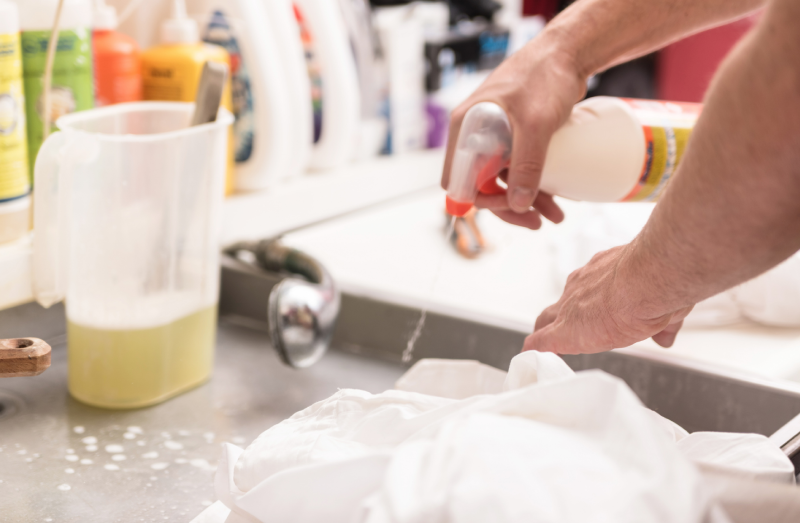Since the second decade of the twentieth century, the dry cleaning and stain remover industry has undergone considerable changes, not only in its washing but also in the spotting treatment and final finishing process of the garments.
For the professional spotter, there are many alternatives of spotting agents available to remove even the most difficult stain. Which one is used depends on the type of fabric and the nature of the stain. The more common stains are:
- Grease and dirt retained by it
- Food, starch-based or sugar-based
- Stains that are deposits of coloring matter on fabrics and whose removal requires special chemicals
ALSO READ: SHOULD YOUR DRY CLEANER OFFER PICKUP AND DELIVERY?
The chemicals used to remove stains can be of a very different nature and a wide variety; however, a broad variety of chemicals have been used and are currently utilized in dry-cleaning operations. Since the range of chemicals is quite wide, we’re going to talk about the most used ones in the business:
Perchlorethylene
It is the most used for the dry cleaning system, also commonly called “PERC”. Accompanied by a special detergent, perchloroethylene gently cleanses the clothes and also does not affect the fibers or the colors so that the clothes maintain the appearance of the first day. No wonder it’s so popular.
However, as a volatile organic solvent, PERC may pose serious health hazards if exposure is not properly controlled.
To avoid any potential health risks, the U.S. Environmental Protection Agency has ruled that dry cleaners located in residential buildings must phase out dry-cleaning machines that use PERC since December 21, 2020. Several jurisdictions have already encouraged or mandated a transition away from PERC.
In Europe, the European directive limits and makes the use of perchloroethylene in dry cleaners more expensive and encourages its replacement in the medium term.
Make sure you check the dry cleaning regulations in your area regarding this chemical to avoid any inconvenience or fine towards your business.
These regulations have led to an accelerated replacement of the PERC in recent years by other washing systems or technologies.

Professional Wet Cleaning (PWC)
This is the safest current alternative according to the Hazardous Waste Management Program in King County. In this cleaning system, fabrics are cleaned with water and detergent in a computer-controlled washing machine with multiple fabric-specific cleaning programs.
These products prevent dye bleeding, protect fibers during drying, among other benefits. The washed fabrics are then placed in a specialized dryer equipped with moisture sensors to ensure that fabrics don’t shrink after excessive drying. Wet cleaning is typically better than PERC at removing water-based stains.
PWC does not generate hazardous organic solvent residues, unlike PERC and most other solvent-based dry cleaning methods.
ALSO READ: 5 IDEAS TO INCREASE YOUR DRY-CLEANING BUSINESS PROFITS
Pre-Spotting:
Nowadays, most dry cleaners have their own type of spotting commonly known as “Pre-Spotting”. This is the treatment to remove stains before dry cleaning or wet cleaning a garment, and it’s known to be chemically soluble or water-soluble.
Oil-based stains may require pre-spotting for effective removal. Biodegradable pre-spotting agents have been specially formulated for wet cleaning systems as wastewater is generally discharged to municipal sewer systems.
There are three types of pre-cleaning/spotting agents: wet-side agents, dry-side agents and bleaches.
- Wet-side agents clean water-soluble stains from clothing
- Dry-side agents remove oily-type stains, stains like grease, fats, paints, waxes, cosmetics, and plastics.
- Bleaches are the alternatives when all of the other stain removers have failed. This is also known as spot bleaching.
Both wet-side agents and dry-side chemicals are used also in the post-spotting process.
Hydrocarbons
Apart from PWC, Hydrocarbons come as an alternative solvent with great force. It has more cleaning power than silicones and a practical effector similar to that of Perchlorethylene. Although the Kauri-butanol index* is lower than that of PERC, the dissolution of dirt from the garments to be treated is ideal to leave them clean, at a level similar to that of PERC. On the other hand, by having a lower Kauri-butanol index, it protects the garments better.
The Final Word
The dry cleaner is faced with a bewildering variety of spotting chemicals, that’s why It’s critical to have some knowledge of the fabrics and the right spotting agents to use on the garment.
With PERC at a disadvantage due to its environmental and human health concerns, new spotting agents like PWC, hydrocarbons or pre-spotting have emerged, giving room to safer and better cleaning methods.
* Kauri-butanol is an international, standardized measure of solvent power for a hydrocarbon solvent

